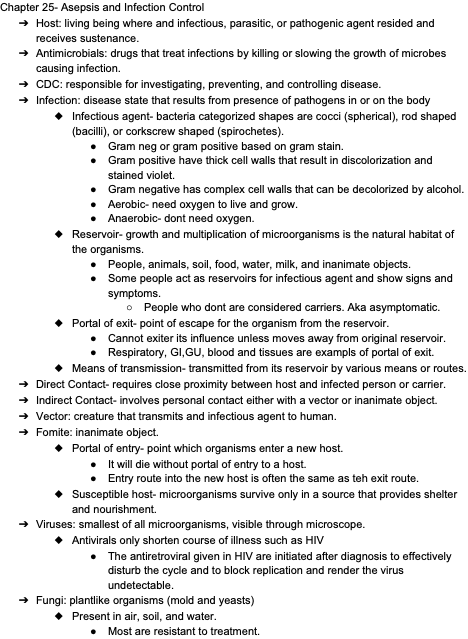Chapter 25: Asepsis and Infection Control
Chapter 25- Asepsis and Infection Control
➔ Host: living being where and infectious, parasitic, or pathogenic agent resided and receives sustenance.
➔ Antimicrobials: drugs that treat infections by killing or slowing the growth of microbes causing infection.
➔ CDC: responsible for investigating, preventing, and controlling disease.
➔ Infection: disease state that results from presence of pathogens in or on the body
◆ Infectious agent- bacteria categorized shapes are cocci (spherical), rod shaped (bacilli), or corkscrew shaped (spirochetes).
● Gram neg or gram positive based on gram stain.
● Gram positive have thick cell walls that result in discolorization and stained violet.
● Gram negative has complex cell walls that can be decolorized by alcohol.
● Aerobic- need oxygen to live and grow.
● Anaerobic- dont need oxygen.
◆ Reservoir- growth and multiplication of microorganisms is the natural habitat of the organisms.
● People, animals, soil, food, water, milk, and inanimate objects.
● Some people act as reservoirs for infectious agent and show signs and symptoms.
○ People who dont are considered carriers. Aka asymptomatic.
◆ Portal of exit- point of escape for the organism from the reservoir.
● Cannot exiter its influence unless moves away from original reservoir.
● Respiratory, GI,GU, blood and tissues are exampls of portal of exit.
◆ Means of transmission- transmitted from its reservoir by various means or routes.
➔ Direct Contact- requires close proximity between host and infected person or carrier.
➔ Indirect Contact- involves personal contact either with a vector or inanimate object.
➔ Vector: creature that transmits and infectious agent to human.
➔ Fomite: inanimate object.
◆ Portal of entry- point which organisms enter a new host.
● It will die without portal of entry to a host.
● Entry route into the new host is often the same as teh exit route.
◆ Susceptible host- microorganisms survive only in a source that provides shelter and nourishment.
➔ Viruses: smallest of all microorganisms, visible through microscope.
◆ Antivirals only shorten course of illness such as HIV
● The antiretroviral given in HIV are initiated after diagnosis to effectively disturb the cycle and to block replication and render the virus undetectable.
➔ Fungi: plantlike organisms (mold and yeasts)
◆ Present in air, soil, and water.
● Most are resistant to treatment.
➔ Parasites: organisms that live on or in a host and rely on it for nourishment.
◆ Organisms potential to produce depends on:
● Number of organisms
● Virulence: the ability to cause disease
● Competence of person’s immune system
● Length and intimacy of contact between person and microorganism.
➔ Endemic: occurs with predictability in one specific region or population.
➔ Pandemic: global outbreaks of a novel virus that did not have an immunization or treatment.
◆ Microorganisms commonly inhabit body sites and are part of the body’s natural defense, the normal flora.
➔ Opportunist: harmless organism that generates infection.
◆ E.Coli- resides in intestinal tract and causes no harm
● When it migrates, can lead to UTI.
◆ C. Diff- resides in the body but not signs of infection.
➔ Colonization: infection is present once the person exhibits specific manifestations of the disease.
Stages of Infection
❖ Incubation period- interval between the pathogens invasion of the body and the appearance of symptoms of infection.
➢ Organisms are growing and multiplying.
❖ Prodromal stage- most infectious. Early signs and symptoms start to present, but often vague.
➢ Last from several hours to several days.
➢ Patient is likely unaware of being contagious
❖ Full stage of Illness-presence of infection specific signs and symptoms.
➢ Determins length and severity of illness.
❖ Convalescent period- involves recovery from infection
➢ Depends on severity and general conditions.
➢ Skin and mucous membrane are the first-line defenses.
■ Others include: normal flora.
❖ Inflammatory response: protective mechanisms
➢ Helps body neutralize, control, or eliminate the offending agent, and prepare the site for repair.
➢ Vascular and Cellular response:
■ Vascular phase, small blood vessels constrict in the area and lead to vasodilation of arterioles and venules that supply the area.
● Histamine is release, leading to increased permeability of vessels, which allows protein-rich fluid to pour onto the area.
■ Cellular state- white blood cells move in the area.
● Neutrophils, primary phagocytes, engulf the organism and consume cell debris and foreign material.

● Exudate is released from wound
◆ Contains red blood cells or pus (purulent).
◆ Amount depend on size and location.
❖ Immune response- involves the collective reaction of the immune system to an invading organism.
➔ Antigen: foreign material invading organism.
➔ Antibody: component of overall immune response
➔ Healthcare associated infections: originating in a hospital.
➔ Exogenous: causative organism acquired from other people.
➔ Endogenous: causative organism comes from microbial life.
➔ Iatrogenic is resulted from treatment or diagnostice procedure.